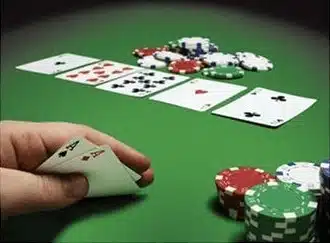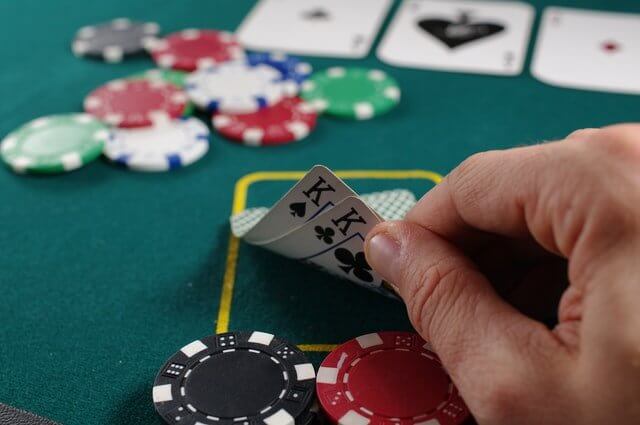If you are tired of playing Texas Hold’em and want to try out a different kind of poker game, Omaha Hold’em just might be the one for you. While similar to Texas hold’em, Omaha has its own set of rules which set it apart from the Texas version. Once you start playing, it becomes second nature and you quickly get into the groove of things.
But the moment you start playing the game, you are going to want to take things up to a higher level. This is where various Omaha poker strategies come into play. Today, our idea is to help you understand the rules of the game. Introduce you to a few strategies that will make the game much more interesting for you to play.
For more gambling tips, try how to play slots or what are poker outs and odds.
- What is Omaha Poker?
- Introduction to Pot Limit Omaha (PLO)
- Pot Limit Omaha vs. Omaha Hi-Lo: Understanding the Differences
- Understanding the Importance of Pot Limit in Omaha Poker
- PLO Pre-Flop Strategies for Success
- Post-flop Strategies in PLO Poker
- Pot Control: A Critical Element of Omaha Poker Strategy
- Conclusion: Mastering Pot Limit Omaha Through Strategy
- FAQ
What is Omaha Poker?
To start with, it is important to differentiate between Texas Hold’em and Omaha Hold’em. While similar, the games actually start differently and require an approach to strategizing that requires a completely different level of thinking.
The first major difference between the two is that instead of two whole cards, players get four whole cards to start with. The five community card rule stays the same. Players actually don’t use all four cards to make a hand, as they can still only use two of them.

To create a hand, players can only use two of their own private cards, and three out of five community cards deal to make a hand. As you can see, this requires a bit more strategizing compared to other types of poker.
Also, the most popular betting structure of Omaha poker is pot-limit. Also known as pot-limit Omaha, abbreviated to PLO, it is completely different from Texas Hold’em which is played with a no-limit structure. While there are other types of structures native to Omaha, PLO is the most popular and used one, so we will mainly concentrate on explaining PLO strategies and how to play PLO.
Introduction to Pot Limit Omaha (PLO)
PLO poker meaning refers to the game being played with a pot-limit. Compared to no-limit poker, usually used in Texas Hold’em, where you can bet any amount up to the size of the stack, in PLO you can only bet up to the total size of the pot.
For instance, if two players are playing one against the other, and the pot has $100 within it, the maximum the first player can bet is exactly $100. In turn, when it is time for the second player to make their move, they can only bet the maximum amount of $400.
The second player’s bet includes the starting pot ($100), the size of the opponent’s bet ($100), and the second player’s call of the first bet ($100). This comes down to $300, plus the added $100 call, making the bet max out at $400.
Pot Limit Omaha vs. Omaha Hi-Lo: Understanding the Differences
Besides playing the regular version of Pot Limit Omaha, you also have the Pot Limit Hi-Lo. A game that adds a completely different ruleset to the table. Omaha Hi-Lo is actually a derivative of the original version. It allows you to win in one of two ways – holding the strongest hand (High) or the weakest hand (Low).
The High hand is usually made by creating hands such as a pair, two pairs, three of a kind, a straight, a flush, or four of a kind, the Low hand can only be made up of cards that have the value of 8 or lower. Flushes and straights are also not counted when creating a Low hand. Also, the Ace is viewed as both the strongest and the weakest card in the set. Allowing you to use it in both High hands and Low hand as well.
Also, Pot Limi Omaha Hi-Lo is played under pot limit rules, meaning that the maximum bet depends on the size of the pot. This rule prevents you from betting all your chips, which is something that you would see in Texas Hold’em.
Since Omaha Hi-Lo includes a split pot mechanic, it means that the lowest hand can win half of the pot, while the highest can win the other half. For that reason, Omaha PLO is more suitable for players who prefer placing high hands instead of lower ones.
Understanding the Importance of Pot Limit in Omaha Poker
PLO strategy can vary due to its limitation to only your pot limit. It also requires a lot more calculating, so you have to think in advance and calculate how much you can actually win. This form is better suited to non high rollers. Being that you are limited to the pot size only, you can’t win a big hand in a single swoop.
On the other hand, big wins are a characteristic of games without a pot limit. In no-limit games, you can bet whatever amount you want, or at least, the amount you can afford. There is nothing preventing you from raising the limit, meaning that bigger wins can happen easily.
PLO Pre-Flop Strategies for Success
In PLO, the starting hand holds much more importance than it has in Texas Hold’em. For that reason, Pre-Flop hands run much closer in poker equity. For instance, a hand that involves double access has an 82.36% advantage over double kings before the flop in Texas Hold’em. However, in Omaha poker, a similar hand only holds a 59.84% chance of winning.

The closeness in Pre-Flop hands is one of the factors that leads to players having to play more hands. Resulting in more flops. Since PLO is more of a drawing game than hold’em it creates bigger pots where most of the chips go into the pot after the flop is dealt.
Post-flop Strategies in PLO Poker
Based on the flop, your way of thinking is drastically different from the one when playing Hold’em poker. It requires you to think twice before acting and reevaluate potential hand strengths before making a move.
There are a few actions that happen post-flop here. You are either going to be betting with buts for value, trying to semi-bluff with strong hands, using position to steal the pot if the opponents are weak, or using position for pot control when not having a nut hand.
Basing it on this, we would then want to play hands that could potentially collect nuts, or play in position. Generally speaking, the main goal of a PLO strategy is to get strong hands-on post-flops to win the showdown. You can also use position to pick up small pots when having strong hands.
Pot Control: A Critical Element of Omaha Poker Strategy
Pot control plays an integral part in PLO, much more than compared to other forms of poker. It’s a very important element of the Omaha poker strategy. The term pot control refers to players being able to maintain the size of the pot, so it does not get too big. This usually happens with marginal hands which don’t guarantee wins in a showdown.
Pot control can be done when you are in position and you decide to check back instead of betting. Also, when you are facing a bet and then decide to call instead of raising it. In both of these situations, you will reach the next step but will not increase the pot in any way.
This tactic can be crucial when playing under the PLO rules. It is particularly valuable when you don’t have a good hand but want to test out your opponent.
Conclusion: Mastering Pot Limit Omaha Through Strategy
If this is the first time you heard of PLO poker, we hope that you are intrigued. It is wildly different from other types of poker and requires different approaches and ways of thinking. If you are already used to playing Hold’em poker, changing to this one is going to radically change your entire way of thinking and strategizing.
Luckily, your pot-limit Omaha strategy does not have to be hard. If you are a skilled player, you will probably be able to adapt to it easily. Beginners might still need more time, but it is not impossible. As long as you work hard at it, start with the basics, and then get better from there, you will easily master pot-limit Omaha in no time.ce of the card you need coming out of the deck.
FAQ
To finish things up on Omaha poker strategies, here are a few added answers.
PLO is short for pot-limit Omaha. It is a type of poker with four cards on draw instead of two and with a pot limit.
Texas Hold’em is a type of poker with a no-limit structure. Meaning that you can make bets without any limits. On the other hand, PLO comes with a pot-limit structure. Meaning that you can’t make a bet larger than the pot size.
One of the best and strongest starting hands in PLO is AAKK. Besides it, there are also AAJT, AAJJ, and AAQQ.
As in any type of poker, bluffing is an extremely important tactic in PLO. However, it does play a lesser role compared to Texas Hold’em due to its play structure.
The most ideal bankroll in PLO is 50 buy-ins. If one buys 100 big blinds maximum at a PLO table, 50 buy-ins will amount to 5,000 big blinds.
Playing in position is probably the best way to control the pot size in PLO. Due to the very fact that PLO is a pot-limit type of game, controlling the pot is already easier. Making the tactics of playing in position the most suitable one for it.






